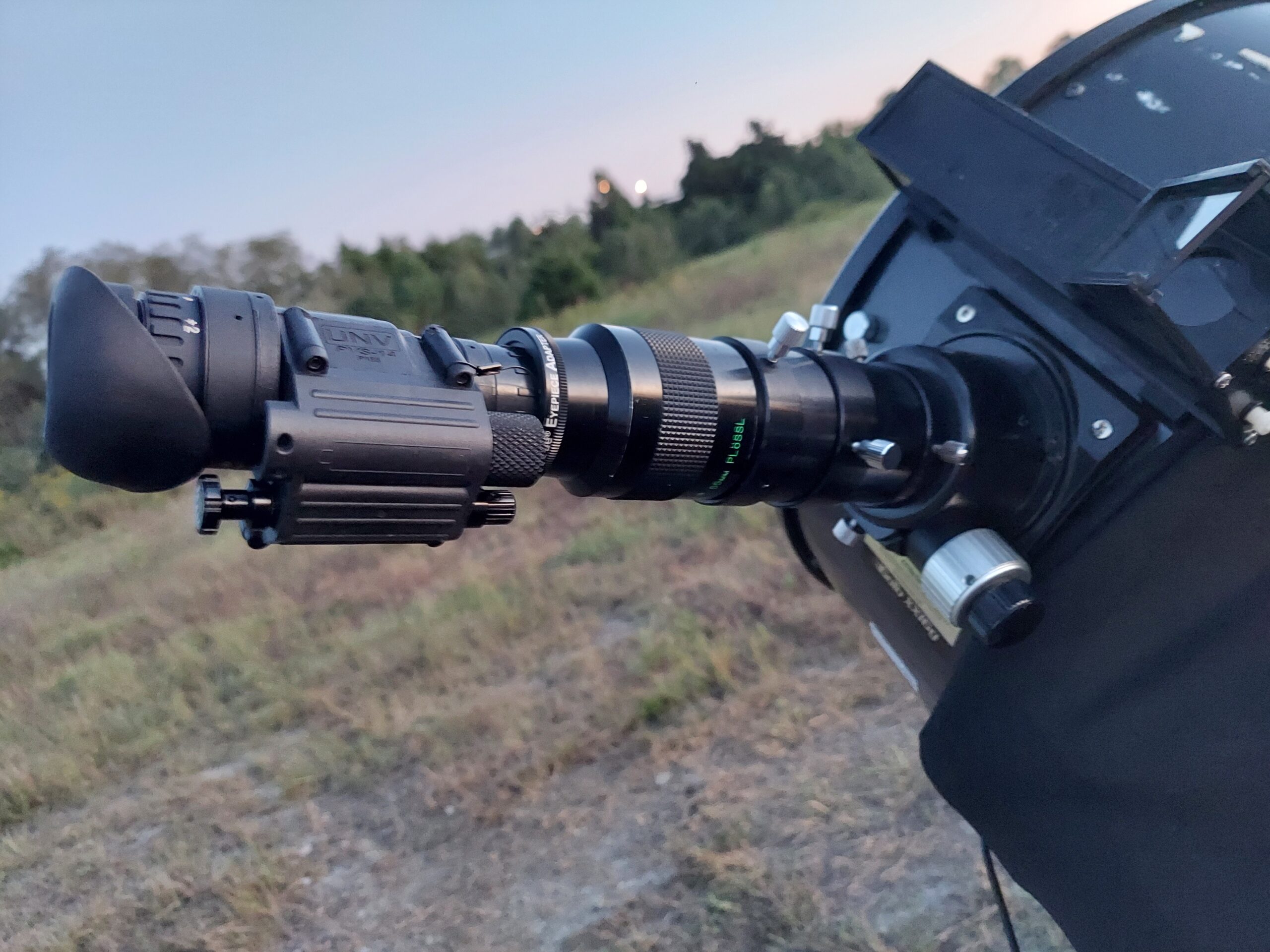Schmidt Cassegrain Telescopes, also called SCTs are a popular kind of telescope because they are compact and easy to use.
Schmidt Cassegrain Telescopes use a spherical mirror with a hole in the middle to collect and focus light, they can be produced fairly inexpensively and
1. Light and Portable
SCT telescopes are compact and lightweight. This makes them the obvious choice for portability.
SCTs with goto mounts are still a bit difficult to transport, but they have a portability edge over a larger reflecting telescope like a Dobsonian.
SCTs fold the light inside the optical tube making them function like a much larger scope without adding weight and length.
2. Focal Length
SCTs have long focal lengths for their size. They accomplish this by folding the light path in half inside the optical tube.
Longer focal allows for higher magnification, but a smaller field of view. Longer focal lengths also restrict the aperture.
There is no “best focal length,” the focal length needs to match your purposes. The longer focal length of an SCT makes it better for visual observing, especially of deep space objects. This post on focal length will give you a table of pros and cons to consider when looking at a scope’s focal length.
The longer focal length presents issues with astrophotography as the field of view provided by the camera needs to match that of the scope and you may have to use accessories like a telecompressor to manipulate the focal length of the scope.

3. Faster to Acclimate
Unless you store your telescope in a backyard observatory or unheated garage, your scope will need to acclimate to the ambient temperature when you bring it out from inside.
The small size of the SCT makes it faster to acclimate, and may eliminate the need for dew heaters. This can be really helpful if you travel often with your scope.
I travel most of the time when I am observing and that acclimation time does eat into my observing time.
4. Frequent Collimation
Schmidt Cassegrain Telescopes require collimation regularly, but not frequently.
The frequency of collimation depends on how you use your telescope. If you are just moving the scope from inside the house to the porch or yard to observe you will probably need to collimate every 3 or more sessions.
When you travel with your scope you want to check the collimation when you arrive at your destination. Check the collimation by defocusing a bright star and ensure the image is a perfect doughnut with an even thickness all around. This should be done after the scope has had a chance to acclimate.
The collimation screws should be tight enough that the mirror does not shift every time it is moved, but not so tight as to put stress on the mirror.
Schmidt Cassegrain Telescopes do not need frequent collimation like Newtonian telescopes. Some SCT owners report only needing to collimate a few times a year. It doesn’t hurt to check the collimation more frequently, but you may not have any adjustments to make.
5. Focus with Primary Mirror
Schmidt Cassegrain Telescopes are designed to be focused by sliding the primary mirror forward and back to achieve focus.
In theory, it should work very well, but in practice it is never quite perfect. Often the mirror shifts slightly when you take your hand off the focuser
The track that holds the primary mirror is never quite perfect resulting in issues with the image
6. Coma
Coma is the elongation of objects near the edge of the field of view in a telescope. Coma is a big problem with Schmidt Cassegrain Telescopes. Coma is caused by the curves in the mirrors in the telescopes.
SCTs use a spherical mirror so coma happens when the mirrors are off axis.
Coma and astigmatism are the most common aberrations with Schmidt Cassegrain Telescopes. These can be corrected with some correcting accessories.
7. Collimation Requires Clear Skies
SCTs need to be collimated rather frequently and the collimation must be done at night, with a star.
To collimate a SCT, you find a star and get it out of focus with the highest magnification possible. You will see a diffraction pattern in the shape of a doughnut. You want to see a perfect doughnut, the circles to be perfectly concentric.
To adjust the collimation most scopes are adjusted with screws that are on the secondary mirror. You may lose the star when you start adjusting screws, which is fine, just recenter the star.
The collimation process is not overly difficult, but the fact that you need clear skies to collimate the scope is tough. When you get started with astronomy you will be amazed how many nights are too cloudy to observe. Knowing that you cannot even collimate in poor seeing conditions is a con for me.
8. Price
Aperture is a very important if not the most important thing to look for in a telescope and an SCT does not give you much aperture for your money.
SCTs do give you a lot of magnification, but the long focal length also makes the field of view very small. This makes astrophotography tricky.
I heard one fellow astronomer say that they ended up needed to use focal reducing accessories for imaging. This negates the benefits that the long focal length gives in terms of magnification.
These factors mean that SCTs are good for portability, but not a great all around telescope.
If portability is very high on your priority list then the price of an SCT may be worth it to you.
9. High Magnification
SCTs are capable of very high magnification, but high magnification might not be what you want. Head over to Sky and Telescope’s article on magnification for some handy formulas to help you understand how to get the ideal magnification for your scope.
Very high magnification may result in images that are too small and too fuzzy to be useful.
10. Narrow Field of View
The long focal length gives Schmidt Cassegrain Telescopes a very narrow field of view.
You can visualize this by looking through a toilet paper tube then look through a paper towel tube, you can see less through the longer tube. That is the brief explanation of focal length. The longer the tube the smaller the field of view.
Longer field of view
This is what allows the SCT to achieve high magnification.
This can be a pro or a con depending on how you intend to use the telescope. High magnification is great for observing details on planets or double clusters.
I will never forget a night with amazing seeing when I was able to use my highest magnification eyepiece and I saw like I had never seen before or since. You can image that weather conditions that allow for a high magnification are rare.
11. Imaging
SCTs are not a preferred camera for imaging for two main reasons:
Weight
SCTs are very light weight and portable, but this makes it easy for the scope to move slightly when imaging. They can be moved slightly in the wind or if it gets bumped.
The portable design for SCTs makes them almost too light for imaging.
Focal Length
Longer focal length is not ideal for astrophotography. The longer focal length makes for a narrow field of view. That means that you will only be able to image small parts of the sky at a time.
The benefit fo the longer focal length is greater magnification. The problem with photographing at high magnification is that it requires very good seeing conditions to achieve crisp images.
I have heard that imaging with an SCT often requires an accessory to reduce focal length. A telescompresser can help reduce focal length to allow the camera and telescope to work together.
Longer focal lengths also require longer exposure times, which are harder to achieve because of the light weight of the telescope.
12. Solar Observing
SCT telescopes can be used for solar observing and they often come with the accessories needed for solar observing.
Solar observing requires filters that block out most of the light that enters the scope so that you do not burn your eyes. If you point a telescope at the sun without solar filters installed the heat and light can cause your telescope to catch fire.
If you haven’t eaten today you can watch this guy burn pigs eyes with a telescope pointed at the sun.
13. Not A Beginner Scope
The SCT is a very specific type of telescope that is not recommended for beginners because it is just not as intuitive as a reflector or refractor.
The cost of Schmidt Cassegrain Telescopes is also very high for the amount of aperture that you get. Aperture is the measure of the amount of light that your telescope can collect, so larger aperture is better in many cases.
Reflector telescopes are also much more intuitive for a beginner. They are cheaper and easier to learn.
I have always had a Dobsonian telescope and I still recommend that most beginners start with one.






